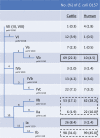Lineage and genogroup-defining single nucleotide polymorphisms of Escherichia coli O157:H7
- PMID: 24014531
- PMCID: PMC3811523
- DOI: 10.1128/AEM.02173-13
Lineage and genogroup-defining single nucleotide polymorphisms of Escherichia coli O157:H7
Abstract
Escherichia coli O157:H7 is a zoonotic human pathogen for which cattle are an important reservoir host. Using both previously published and new sequencing data, a 48-locus single nucleotide polymorphism (SNP)-based typing panel was developed that redundantly identified 11 genogroups that span six of the eight lineages recently described for E. coli O157:H7 (J. L. Bono, T. P. Smith, J. E. Keen, G. P. Harhay, T. G. McDaneld, R. E. Mandrell, W. K. Jung, T. E. Besser, P. Gerner-Smidt, M. Bielaszewska, H. Karch, M. L. Clawson, Mol. Biol. Evol. 29:2047-2062, 2012) and additionally defined subgroups within four of those lineages. This assay was applied to 530 isolates from human and bovine sources. The SNP-based lineage groups were concordant with previously identified E. coli O157:H7 genotypes identified by other methods and were strongly associated with carriage of specific Stx genes. Two SNP lineages (Ia and Vb) were disproportionately represented among cattle isolates, and three others (IIa, Ib, and IIb) were disproportionately represented among human clinical isolates. This 48-plex SNP assay efficiently and economically identifies biologically relevant lineages within E. coli O157:H7.
Figures

References
-
- García A, Fox JG, Besser TE. 2010. Zoonotic enterohemorrhagic Escherichia coli: a One Health perspective. ILAR J. 51:221–232 - PubMed
-
- Caprioli A, Morabito S, Brugere H, Oswald E. 2005. Enterohaemorrhagic Escherichia coli: emerging issues on virulence and modes of transmission. Vet. Res. 36:289–311 - PubMed
-
- Melton-Celsa AR, Rogers JE, Schmitt CK, Darnell SC, O'Brien AD. 1998. Virulence of Shiga toxin-producing Escherichia coli (STEC) in orally-infected mice correlates with the type of toxin produced by the infecting strain. Jpn. J. Med. Sci. Biol. 51(Suppl):S108–S114 - PubMed
Publication types
MeSH terms
Substances
LinkOut - more resources
Full Text Sources
Other Literature Sources

